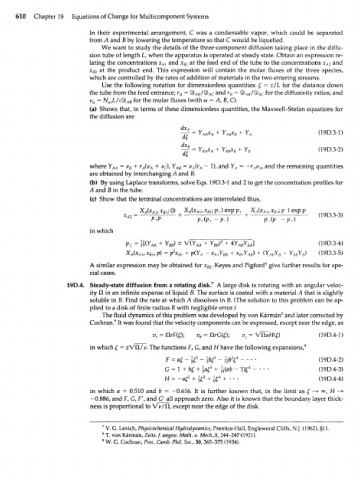Page 630 - Bird R.B. Transport phenomena
P. 630
610 Chapter 19 Equations of Change for Multicomponent Systems
In their experimental arrangement, С was a condensable vapor, which could be separated
from A and В by lowering the temperature so that С would be liquefied.
We want to study the details of the three-component diffusion taking place in the diffu-
sion tube of length L, when the apparatus is operated at steady state. Obtain an expression re-
lating the concentrations x A] and x m at the feed end of the tube to the concentrations x A2 and
x B2 at the product end. This expression will contain the molar fluxes of the three species,
which are controlled by the rates of addition of materials in the two entering streams.
Use the following notation for dimensionless quantities: £ = z/L for the distance down
the tube from the feed entrance; r A = 4b AB/4b AC and r B = 3) ./0) for the diffusivity ratios; and
вс
ль
v a = N L/c3) AB for the molar fluxes (with a = А, В, С).
QZ
(a) Shows that, in terms of these dimensionless quantities, the Maxwell-Stefan equations for
the diffusion are
+
• Y AB x B Y A
Щ = Y x + Y x + Y (19D.3-2)
BA A BB B B
where У лл = v + г (^ л + y ), У лв = ^ (г - 1), and Y A = ~r v , and the remaining quantities
л
B
A A
c
л
л
are obtained by interchanging A and B.
(b) By using Laplace transforms, solve Eqs. 19D.3-1 and 2 to get the concentration profiles for
A and В in the tube.
(c) Show that the terminal concentrations are interrelated thus,
_X A {x AU x B} ;0) X A {x AU x Bl ;p+)expp + X A (x M ,x B] ;p ) exp p М О ¥ Л О _
X A 2 — —— ~r ; 1 — \iy\J.D-5)
V+V- рЛр + -р-) рЛр -р + )
in which
V, = ШЛА + YBB) ± V(Y^ + Y BB ) 2 + 4У„У Ь , Л ] (19D.3-4)
ХлЬли хви Р) = ?*АХ + P(YA ~ x M Y BB + x B] Y AB ) + (Y AP Y B - Y BD Y A ) (19D.3-5)
A similar expression may be obtained for x . Keyes and Pigford' give further results for spe-
(
B1
cial cases.
19D.4. Steady-state diffusion from a rotating disk. 7 A large disk is rotating with an angular veloc-
ity Vi in an infinite expanse of liquid B. The surface is coated with a material A that is slightly
soluble in B. Find the rate at which A dissolves in B. (The solution to this problem can be ap-
plied to a disk of finite radius R with negligible error.)
The fluid dynamics of this problem was developed by von Karman and later corrected by
8
Cochran. It was found that the velocity components can be expressed, except near the edge, as
9
v = £lrF(Q; v e = D,rG(0; = Vlh>H(0 (19D.4-1)
r v z
in which £ = zwOjv. The functions F, G, and H have the following expansions, 8
2
F = at-\t - \Ъ£ Ъ - WC (19D.4-2)
G = 1 + Ц + \a? + ~(ab - 1)£ 4 (19D.4-3)
H = -a? + k 3 + k 4 + • ' • (19D.4-4)
in which a = 0.510 and b = -0.616. It is further known that, in the limit as f —> °°, H —>
-0.886, and F, G, F', and G' all approach zero. Also it is known that the boundary layer thick-
ness is proportional to \TvJVL, except near the edge of the disk.
7
V. G. Levich, Physicochemical Hydrodynamics, Prentice-Hall, Englewood Cliffs, N.J. (1962), §11.
8
T. von Karman, Zeits. f. angew. Math. u. Mech.,1, 244-247 (1921).
9
W. G. Cochran, Proc. Camb. Phil. Soc, 30, 365-375 (1934).

